Stabilizing the Shield: C-Terminal Tail Mutation of HMPV F Protein for Enhanced Vaccine Design
Abstract
1. Introduction
2. Materials and Methods
2.1. Mutation of the Target Protein
2.2. MD (Molecular Dynamics) Simulation
3. Results and Discussion
3.1. Design of Prefusion-Stabilized HMPV F Protein
3.2. Immunogenic Sites of the Prefusion F-Protein
3.3. Substitution of Hydrophobic Mutations in the C-Terminal Trimeric Structure of HMPV F Protein
3.4. Characterization of Protein Structure of Mutants
4. Conclusions
Supplementary Materials
Author Contributions
Funding
Institutional Review Board Statement
Informed Consent Statement
Data Availability Statement
Conflicts of Interest
References
- Akingbola, A.; Adegbesan, A.; TundeAlao, S.; Adewole, O.; Ayikoru, C.; Benson, A.E.; Shekoni, M.; Chuku, J. Human Metapneumovirus: An Emerging Respiratory Pathogen and the Urgent Need for Improved Diagnostics, Surveillance, and Vaccine Development. Infect. Dis. 2025, 57, 304–310. [Google Scholar] [CrossRef]
- van den Hoogen, B.G.; de Jong, J.C.; Groen, J.; Kuiken, T.; de Groot, R.; Fouchier, R.A.; Osterhaus, A.D. A Newly Discovered Human Pneumovirus Isolated from Young Children with Respiratory Tract Disease. Nat. Med. 2001, 7, 719–724. [Google Scholar] [CrossRef]
- Shafagati, N.; Williams, J. Human Metapneumovirus—What We Know Now. F1000Research 2018, 7, 135. [Google Scholar] [CrossRef]
- Deval, H.; Kumar, N.; Srivastava, M.; Potdar, V.; Mehta, A.; Verma, A.; Singh, R.; Kavathekar, A.; Kant, R.; Murhekar, M. Human Metapneumovirus (hMPV): An Associated Etiology of Severe Acute Respiratory Infection in Children of Eastern Uttar Pradesh, India. Access Microbiol. 2024, 6, 000829.v4. [Google Scholar] [CrossRef]
- Mishra, B.; Mohapatra, D.; Tripathy, M.; Mamidi, P.; Mohapatra, P.R. A Re-Emerging Respiratory Virus: Human Metapneumovirus (hMPV). Cureus 2025, 17, e78354. [Google Scholar] [CrossRef]
- Tannock, G.A.; Kim, H.; Xue, L. Why Are Vaccines against Many Human Viral Diseases Still Unavailable; an Historic Perspective? J. Med. Virol. 2020, 92, 129–138. [Google Scholar] [CrossRef]
- van den Hoogen, B.G.; Bestebroer, T.M.; Osterhaus, A.D.M.E.; Fouchier, R.A.M. Analysis of the Genomic Sequence of a Human Metapneumovirus. Virology 2002, 295, 119–132. [Google Scholar] [CrossRef]
- Hsieh, C.-L.; Rush, S.A.; Palomo, C.; Chou, C.-W.; Pickens, W.; Más, V.; McLellan, J.S. Structure-Based Design of Prefusion-Stabilized Human Metapneumovirus Fusion Proteins. Nat. Commun. 2022, 13, 1299. [Google Scholar] [CrossRef]
- Battles, M.B.; McLellan, J.S. Respiratory Syncytial Virus Entry and How to Block It. Nat. Rev. Microbiol. 2019, 17, 233–245. [Google Scholar] [CrossRef]
- Liang, Y.; Shao, S.; Li, X.Y.; Zhao, Z.X.; Liu, N.; Liu, Z.M.; Shen, F.J.; Zhang, H.; Hou, J.W.; Zhang, X.F.; et al. Mutating a Flexible Region of the RSV F Protein Can Stabilize the Prefusion Conformation. Science 2024, 385, 1484–1491. [Google Scholar] [CrossRef]
- Mas, V.; Nair, H.; Campbell, H.; Melero, J.A.; Williams, T.C. Antigenic and Sequence Variability of the Human Respiratory Syncytial Virus F Glycoprotein Compared to Related Viruses in a Comprehensive Dataset. Vaccine 2018, 36, 6660–6673. [Google Scholar] [CrossRef]
- Trinité, B.; Durr, E.; Pons-Grífols, A.; O’Donnell, G.; Aguilar-Gurrieri, C.; Rodriguez, S.; Urrea, V.; Tarrés, F.; Mane, J.; Ortiz, R.; et al. VLPs Generated by the Fusion of RSV-F or hMPV-F Glycoprotein to HIV-Gag Show Improved Immunogenicity and Neutralizing Response in Mice. Vaccine 2024, 42, 3474–3485. [Google Scholar] [CrossRef]
- Lee, Y.-Z.; Han, J.; Zhang, Y.-N.; Ward, G.; Braz Gomes, K.; Auclair, S.; Stanfield, R.L.; He, L.; Wilson, I.A.; Zhu, J. Rational Design of Uncleaved Prefusion-Closed Trimer Vaccines for Human Respiratory Syncytial Virus and Metapneumovirus. Nat. Commun. 2024, 15, 9939. [Google Scholar] [CrossRef]
- Schneider-Ohrum, K.; Cayatte, C.; Bennett, A.S.; Rajani, G.M.; McTamney, P.; Nacel, K.; Hostetler, L.; Cheng, L.; Ren, K.; O’Day, T.; et al. Immunization with Low Doses of Recombinant Postfusion or Prefusion Respiratory Syncytial Virus F Primes for Vaccine-Enhanced Disease in the Cotton Rat Model Independently of the Presence of a Th1-Biasing (GLA-SE) or Th2-Biasing (Alum) Adjuvant. J. Virol. 2017, 91, e02180-16. [Google Scholar] [CrossRef]
- Battles, M.B.; Más, V.; Olmedillas, E.; Cano, O.; Vázquez, M.; Rodríguez, L.; Melero, J.A.; McLellan, J.S. Structure and Immunogenicity of Pre-Fusion-Stabilized Human Metapneumovirus F Glycoprotein. Nat. Commun. 2017, 8, 1528. [Google Scholar] [CrossRef]
- Krarup, A.; Truan, D.; Furmanova-Hollenstein, P.; Bogaert, L.; Bouchier, P.; Bisschop, I.J.M.; Widjojoatmodjo, M.N.; Zahn, R.; Schuitemaker, H.; McLellan, J.S.; et al. A Highly Stable Prefusion RSV F Vaccine Derived from Structural Analysis of the Fusion Mechanism. Nat. Commun. 2015, 6, 8143. [Google Scholar] [CrossRef]
- Stewart-Jones, G.B.E.; Thomas, P.V.; Chen, M.; Druz, A.; Joyce, M.G.; Kong, W.-P.; Sastry, M.; Soto, C.; Yang, Y.; Zhang, B.; et al. A Cysteine Zipper Stabilizes a Pre-Fusion F Glycoprotein Vaccine for Respiratory Syncytial Virus. PLoS ONE 2015, 10, e0128779. [Google Scholar] [CrossRef]
- Swanson, K.A.; Settembre, E.C.; Shaw, C.A.; Dey, A.K.; Rappuoli, R.; Mandl, C.W.; Dormitzer, P.R.; Carfi, A. Structural Basis for Immunization with Postfusion Respiratory Syncytial Virus Fusion F Glycoprotein (RSV F) to Elicit High Neutralizing Antibody Titers. Proc. Natl. Acad. Sci. USA 2011, 108, 9619–9624. [Google Scholar] [CrossRef]
- Lin, M.; Yin, Y.; Zhao, X.; Wang, C.; Zhu, X.; Zhan, L.; Chen, L.; Wang, S.; Lin, X.; Zhang, J.; et al. A Truncated Pre-F Protein mRNA Vaccine Elicits an Enhanced Immune Response and Protection against Respiratory Syncytial Virus. Nat. Commun. 2025, 16, 1386. [Google Scholar] [CrossRef]
- Su, C.; Zhong, Y.; Zhao, G.; Hou, J.; Zhang, S.; Wang, B. RSV Pre-Fusion F Protein Enhances the G Protein Antibody and Anti-Infectious Responses. npj Vaccines 2022, 7, 168. [Google Scholar] [CrossRef]
- Wang, S.; Liang, B.; Wang, W.; Li, L.; Feng, N.; Zhao, Y.; Wang, T.; Yan, F.; Yang, S.; Xia, X. Viral Vectored Vaccines: Design, Development, Preventive and Therapeutic Applications in Human Diseases. Signal Transduct. Target. Ther. 2023, 8, 149. [Google Scholar] [CrossRef]
- Bakkers, M.J.G.; Ritschel, T.; Tiemessen, M.; Dijkman, J.; Zuffianò, A.A.; Yu, X.; van Overveld, D.; Le, L.; Voorzaat, R.; van Haaren, M.M.; et al. Efficacious Human Metapneumovirus Vaccine Based on AI-Guided Engineering of a Closed Prefusion Trimer. Nat. Commun. 2024, 15, 6270. [Google Scholar] [CrossRef]
- Gilman, M.S.A.; Furmanova-Hollenstein, P.; Pascual, G.; B van ’t Wout, A.; Langedijk, J.P.M.; McLellan, J.S. Transient Opening of Trimeric Prefusion RSV F Proteins. Nat. Commun. 2019, 10, 2105. [Google Scholar] [CrossRef]
- Más, V.; Rodriguez, L.; Olmedillas, E.; Cano, O.; Palomo, C.; Terrón, M.C.; Luque, D.; Melero, J.A.; McLellan, J.S. Engineering, Structure and Immunogenicity of the Human Metapneumovirus F Protein in the Postfusion Conformation. PLoS Pathog. 2016, 12, e1005859. [Google Scholar] [CrossRef]
- Huang, J.; Chopra, P.; Liu, L.; Nagy, T.; Murray, J.; Tripp, R.A.; Boons, G.-J.; Mousa, J.J. Structure, Immunogenicity, and Conformation-Dependent Receptor Binding of the Postfusion Human Metapneumovirus F Protein. J. Virol. 2021, 95, e0059321. [Google Scholar] [CrossRef]
- White, J.M.; Delos, S.E.; Brecher, M.; Schornberg, K. Structures and Mechanisms of Viral Membrane Fusion Proteins: Multiple Variations on a Common Theme. Crit. Rev. Biochem. Mol. Biol. 2008, 43, 189–219. [Google Scholar] [CrossRef]
- Yang, K.; Wang, C.; White, K.I.; Pfuetzner, R.A.; Esquivies, L.; Brunger, A.T. Structural Conservation among Variants of the SARS-CoV-2 Spike Postfusion Bundle. Proc. Natl. Acad. Sci. USA 2022, 119, e2119467119. [Google Scholar] [CrossRef]
- Rush, S.A.; Brar, G.; Hsieh, C.-L.; Chautard, E.; Rainho-Tomko, J.N.; Slade, C.D.; Bricault, C.A.; Kume, A.; Kearns, J.; Groppo, R.; et al. Characterization of Prefusion-F-Specific Antibodies Elicited by Natural Infection with Human Metapneumovirus. Cell Rep. 2022, 40, 111399. [Google Scholar] [CrossRef]
- Kelleher, K.; Subramaniam, N.; Drysdale, S.B. The Recent Landscape of RSV Vaccine Research. Ther. Adv. Vaccines Immunother. 2025, 13, 25151355241310601. [Google Scholar] [CrossRef]
- McLellan, J.S.; Ray, W.C.; Peeples, M.E. Structure and Function of Respiratory Syncytial Virus Surface Glycoproteins. Curr. Top. Microbiol. Immunol. 2013, 372, 83–104. [Google Scholar] [CrossRef]
- Nuttens, C.; Moyersoen, J.; Curcio, D.; Aponte-Torres, Z.; Baay, M.; Vroling, H.; Gessner, B.D.; Begier, E. Differences Between RSV A and RSV B Subgroups and Implications for Pharmaceutical Preventive Measures. Infect. Dis. Ther. 2024, 13, 1725–1742. [Google Scholar] [CrossRef] [PubMed]
- Guo, L.; Li, L.; Liu, L.; Zhang, T.; Sun, M. Neutralising Antibodies against Human Metapneumovirus. Lancet Microbe 2023, 4, e732–e744. [Google Scholar] [CrossRef] [PubMed]
- Huang, J.; Diaz, D.; Mousa, J.J. Antibody Recognition of the Pneumovirus Fusion Protein Trimer Interface. PLoS Pathog. 2020, 16, e1008942. [Google Scholar] [CrossRef]
- Belot, L.; Ouldali, M.; Roche, S.; Legrand, P.; Gaudin, Y.; Albertini, A.A. Crystal Structure of Mokola Virus Glycoprotein in Its Post-Fusion Conformation. PLoS Pathog. 2020, 16, e1008383. [Google Scholar] [CrossRef]
- Olmedillas, E.; Rajamanickam, R.R.; Avalos, R.D.; Sosa, F.A.; Zandonatti, M.A.; Harkins, S.S.; Shresta, S.; Hastie, K.M.; Saphire, E.O. Structure of a SARS-CoV-2 Spike S2 Subunit in a Pre-Fusion, Open Conformation. bioRxiv 2023. [Google Scholar] [CrossRef]
- He, L.; Kumar, S.; Allen, J.D.; Huang, D.; Lin, X.; Mann, C.J.; Saye-Francisco, K.L.; Copps, J.; Sarkar, A.; Blizard, G.S.; et al. HIV-1 Vaccine Design through Minimizing Envelope Metastability. Sci. Adv. 2018, 4, eaau6769. [Google Scholar] [CrossRef]
- He, L.; Lin, X.; Wang, Y.; Abraham, C.; Sou, C.; Ngo, T.; Zhang, Y.; Wilson, I.A.; Zhu, J. Single-Component, Self-Assembling, Protein Nanoparticles Presenting the Receptor Binding Domain and Stabilized Spike as SARS-CoV-2 Vaccine Candidates. Sci. Adv. 2021, 7, eabf1591. [Google Scholar] [CrossRef]
- Roche, S.; Gaudin, Y. Characterization of the Equilibrium between the Native and Fusion-Inactive Conformation of Rabies Virus Glycoprotein Indicates That the Fusion Complex Is Made of Several Trimers. Virology 2002, 297, 128–135. [Google Scholar] [CrossRef]
- Gonzalez, K.J.; Huang, J.; Criado, M.F.; Banerjee, A.; Tompkins, S.M.; Mousa, J.J.; Strauch, E.-M. A General Computational Design Strategy for Stabilizing Viral Class I Fusion Proteins. Nat. Commun. 2024, 15, 1335. [Google Scholar] [CrossRef]
- Kinder, J.T.; Klimyte, E.M.; Chang, A.; Williams, J.V.; Dutch, R.E. Human Metapneumovirus Fusion Protein Triggering: Increasing Complexities by Analysis of New HMPV Fusion Proteins. Virology 2019, 531, 248–254. [Google Scholar] [CrossRef]
- Ou, L.; Chen, S.J.; Teng, I.-T.; Yang, L.; Zhang, B.; Zhou, T.; Biju, A.; Cheng, C.; Kong, W.-P.; Morano, N.C.; et al. Structure-Based Design of a Single-Chain Triple-Disulfide-Stabilized Fusion-Glycoprotein Trimer That Elicits High-Titer Neutralizing Responses against Human Metapneumovirus. PLoS Pathog. 2023, 19, e1011584. [Google Scholar] [CrossRef] [PubMed]
- McLellan, J.S.; Chen, M.; Joyce, M.G.; Sastry, M.; Stewart-Jones, G.B.E.; Yang, Y.; Zhang, B.; Chen, L.; Srivatsan, S.; Zheng, A.; et al. Structure-Based Design of a Fusion Glycoprotein Vaccine for Respiratory Syncytial Virus. Science 2013, 342, 592–598. [Google Scholar] [CrossRef] [PubMed]
- Deng, L.; Cao, H.; Li, G.; Zhou, K.; Fu, Z.; Zhong, J.; Wang, Z.; Yang, X. Progress on Respiratory Syncytial Virus Vaccine Development and Evaluation Methods. Vaccines 2025, 13, 304. [Google Scholar] [CrossRef]
- Pieper, U.; Webb, B.M.; Dong, G.Q.; Schneidman-Duhovny, D.; Fan, H.; Kim, S.J.; Khuri, N.; Spill, Y.G.; Weinkam, P.; Hammel, M.; et al. ModBase, a Database of Annotated Comparative Protein Structure Models and Associated Resources. Nucleic Acids Res. 2014, 42, D336–D346. [Google Scholar] [CrossRef] [PubMed]
- Wiederstein, M.; Sippl, M.J. ProSA-Web: Interactive Web Service for the Recognition of Errors in Three-Dimensional Structures of Proteins. Nucleic Acids Res. 2007, 35, W407–W410. [Google Scholar] [CrossRef]
- Ko, J.; Park, H.; Heo, L.; Seok, C. GalaxyWEB Server for Protein Structure Prediction and Refinement. Nucleic Acids Res. 2012, 40, W294–W297. [Google Scholar] [CrossRef]
- Rodrigues, C.H.M.; Pires, D.E.V.; Ascher, D.B. DynaMut2: Assessing Changes in Stability and Flexibility upon Single and Multiple Point Missense Mutations. Protein Sci. 2021, 30, 60–69. [Google Scholar] [CrossRef]
- Laskowski, R.A.; MacArthur, M.W.; Moss, D.S.; Thornton, J.M. PROCHECK: A Program to Check the Stereochemical Quality of Protein Structures. J. Appl. Crystallogr. 1993, 26, 283–291. [Google Scholar] [CrossRef]
- Saih, A.; Bouqdayr, M.; Baba, H.; Hamdi, S.; Moussamih, S.; Bennani, H.; Saile, R.; Wakrim, L.; Kettani, A. Computational Analysis of Missense Variants in the Human Transmembrane Protease Serine 2 (TMPRSS2) and SARS-CoV-2. Biomed Res. Int. 2021, 2021, 9982729. [Google Scholar] [CrossRef]
- Bagaria, A.; Jaravine, V.; Huang, Y.J.; Montelione, G.T.; Güntert, P. Protein Structure Validation by Generalized Linear Model Root-Mean-Square Deviation Prediction. Protein Sci. 2012, 21, 229–238. [Google Scholar] [CrossRef]
- Kufareva, I.; Abagyan, R. Methods of Protein Structure Comparison. Methods Mol. Biol. 2012, 857, 231–257. [Google Scholar] [CrossRef] [PubMed]
- Sanchez-Trincado, J.L.; Gomez-Perosanz, M.; Reche, P.A. Fundamentals and Methods for T- and B-Cell Epitope Prediction. J. Immunol. Res. 2017, 2017, 2680160. [Google Scholar] [CrossRef]
- Schrödinger, L.; DeLano, W. PyMOL. 2020. Available online: http://www.pymol.org/pymol (accessed on 8 July 2025).
- Van Der Spoel, D.; Lindahl, E.; Hess, B.; Groenhof, G.; Mark, A.E.; Berendsen, H.J.C. GROMACS: Fast, Flexible, and Free. J. Comput. Chem. 2005, 26, 1701–1718. [Google Scholar] [CrossRef]
- Huang, J.; MacKerell, A.D. CHARMM36 All-Atom Additive Protein Force Field: Validation Based on Comparison to NMR Data. J. Comput. Chem. 2013, 34, 2135–2145. [Google Scholar] [CrossRef] [PubMed]
- Darden, T.; York, D.; Pedersen, L. Particle Mesh Ewald: An N⋅log(N) Method for Ewald Sums in Large Systems. J. Chem. Phys. 1993, 98, 10089–10092. [Google Scholar] [CrossRef]
- Hess, B.; Bekker, H.; Berendsen, H.J.C.; Fraaije, J.G.E.M. LINCS: A Linear Constraint Solver for Molecular Simulations. J. Comput. Chem. 1997, 18, 1463–1472. [Google Scholar] [CrossRef]
- Bussi, G.; Donadio, D.; Parrinello, M. Canonical Sampling through Velocity Rescaling. J. Chem. Phys. 2007, 126, 014101. [Google Scholar] [CrossRef]
- Berendsen, H.J.C.; Postma, J.P.M.; van Gunsteren, W.F.; DiNola, A.; Haak, J.R. Molecular Dynamics with Coupling to an External Bath. J. Chem. Phys. 1984, 81, 3684–3690. [Google Scholar] [CrossRef]
- Roth, J.; Zuber, C.; Park, S.; Jang, I.; Lee, Y.; Kysela, K.G.; Fourn, V.L.; Santimaria, R.; Guhl, B.; Cho, J.W. Protein N-Glycosylation, Protein Folding, and Protein Quality Control. Mol. Cells 2010, 30, 497–506. [Google Scholar] [CrossRef]
- Scheiblhofer, S.; Laimer, J.; Machado, Y.; Weiss, R.; Thalhamer, J. Influence of Protein Fold Stability on Immunogenicity and Its Implications for Vaccine Design. Expert Rev. Vaccines 2017, 16, 479–489. [Google Scholar] [CrossRef]
- Crooke, S.N.; Ovsyannikova, I.G.; Kennedy, R.B.; Poland, G.A. Immunoinformatic Identification of B Cell and T Cell Epitopes in the SARS-CoV-2 Proteome. Sci. Rep. 2020, 10, 14179. [Google Scholar] [CrossRef]
- Ramirez-Ramirez, J.; Martin-Diaz, J.; Pastor, N.; Alcalde, M.; Ayala, M. Exploring the Role of Phenylalanine Residues in Modulating the Flexibility and Topography of the Active Site in the Peroxygenase Variant PaDa-I. Int. J. Mol. Sci. 2020, 21, 5734. [Google Scholar] [CrossRef]
- Senthil, R.; Usha, S.; Saravanan, K.M. Importance of Fluctuating Amino Acid Residues in Folding and Binding of Proteins. Avicenna J. Med. Biotechnol. 2019, 11, 339–343. [Google Scholar]
- Kathuria, S.V.; Chan, Y.H.; Nobrega, R.P.; Özen, A.; Matthews, C.R. Clusters of Isoleucine, Leucine, and Valine Side Chains Define Cores of Stability in High-Energy States of Globular Proteins: Sequence Determinants of Structure and Stability. Protein Sci. 2016, 25, 662–675. [Google Scholar] [CrossRef] [PubMed]
- Zhu, B.Y.; Zhou, N.E.; Kay, C.M.; Hodges, R.S. Packing and Hydrophobicity Effects on Protein Folding and Stability: Effects of Beta-Branched Amino Acids, Valine and Isoleucine, on the Formation and Stability of Two-Stranded Alpha-Helical Coiled Coils/Leucine Zippers. Protein Sci. 1993, 2, 383–394. [Google Scholar] [CrossRef]
- Brosnan, J.T.; Brosnan, M.E. Branched-Chain Amino Acids: Enzyme and Substrate Regulation. J. Nutr. 2006, 136, 207S–211S. [Google Scholar] [CrossRef]
- Shao, J.; Kuiper, B.P.; Thunnissen, A.-M.W.H.; Cool, R.H.; Zhou, L.; Huang, C.; Dijkstra, B.W.; Broos, J. The Role of Tryptophan in π Interactions in Proteins: An Experimental Approach. J. Am. Chem. Soc. 2022, 144, 13815–13822. [Google Scholar] [CrossRef]
- Zhou, H.-X.; Pang, X. Electrostatic Interactions in Protein Structure, Folding, Binding, and Condensation. Chem. Rev. 2018, 118, 1691–1741. [Google Scholar] [CrossRef] [PubMed]
- Xiao, F.; Chen, Z.; Wei, Z.; Tian, L. Hydrophobic Interaction: A Promising Driving Force for the Biomedical Applications of Nucleic Acids. Adv. Sci. 2020, 7, 2001048. [Google Scholar] [CrossRef] [PubMed]
- Valley, C.C.; Cembran, A.; Perlmutter, J.D.; Lewis, A.K.; Labello, N.P.; Gao, J.; Sachs, J.N. The Methionine-Aromatic Motif Plays a Unique Role in Stabilizing Protein Structure. J. Biol. Chem. 2012, 287, 34979–34991. [Google Scholar] [CrossRef]
- Qing, R.; Hao, S.; Smorodina, E.; Jin, D.; Zalevsky, A.; Zhang, S. Protein Design: From the Aspect of Water Solubility and Stability. Chem. Rev. 2022, 122, 14085–14179. [Google Scholar] [CrossRef] [PubMed]
- Fan, R.; Yuan, Y.; Zhang, Q.; Zhou, X.-R.; Jia, L.; Liu, Z.; Yu, C.; Luo, S.-Z.; Chen, L. Isoleucine/Leucine Residues at “a” and “d” Positions of a Heptad Repeat Sequence Are Crucial for the Cytolytic Activity of a Short Anticancer Lytic Peptide. Amino Acids 2017, 49, 193–202. [Google Scholar] [CrossRef]
- Ulmschneider, M.B.; Sansom, M.S. Amino Acid Distributions in Integral Membrane Protein Structures. Biochim. Biophys. Acta 2001, 1512, 1–14. [Google Scholar] [CrossRef]
- Sun, Q. The Hydrophobic Effects: Our Current Understanding. Molecules 2022, 27, 7009. [Google Scholar] [CrossRef]
- Li, Y.; Huang, Y.; Swaminathan, C.P.; Smith-Gill, S.J.; Mariuzza, R.A. Magnitude of the Hydrophobic Effect at Central versus Peripheral Sites in Protein-Protein Interfaces. Structure 2005, 13, 297–307. [Google Scholar] [CrossRef] [PubMed]
- Best, R.B.; Mittal, J. Protein Simulations with an Optimized Water Model: Cooperative Helix Formation and Temperature-Induced Unfolded State Collapse. J. Phys. Chem. B 2010, 114, 14916–14923. [Google Scholar] [CrossRef] [PubMed]
- Aurora, R.; Rose, G.D. Helix Capping. Protein Sci 1998, 7, 21–38. [Google Scholar] [CrossRef]
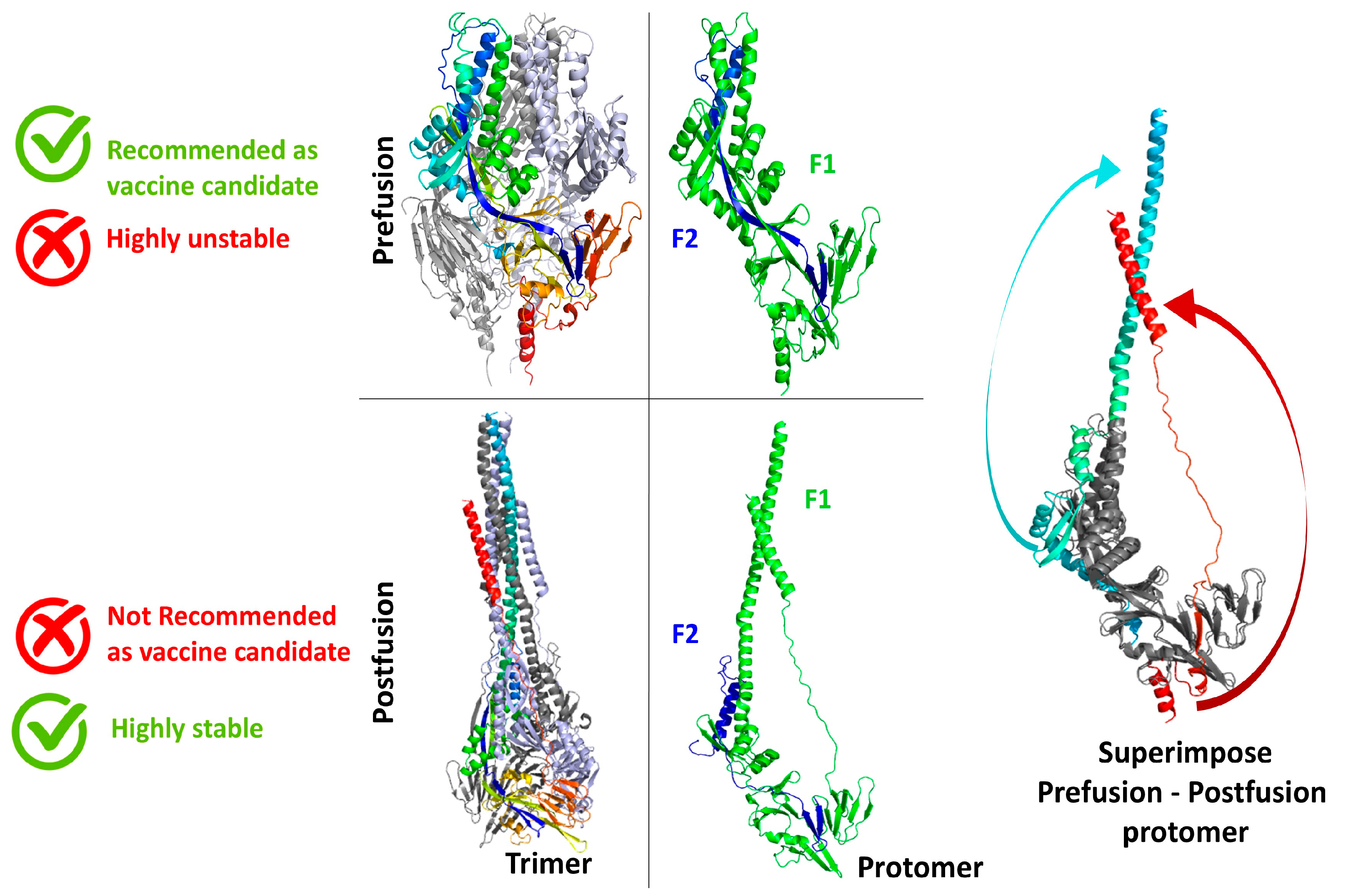
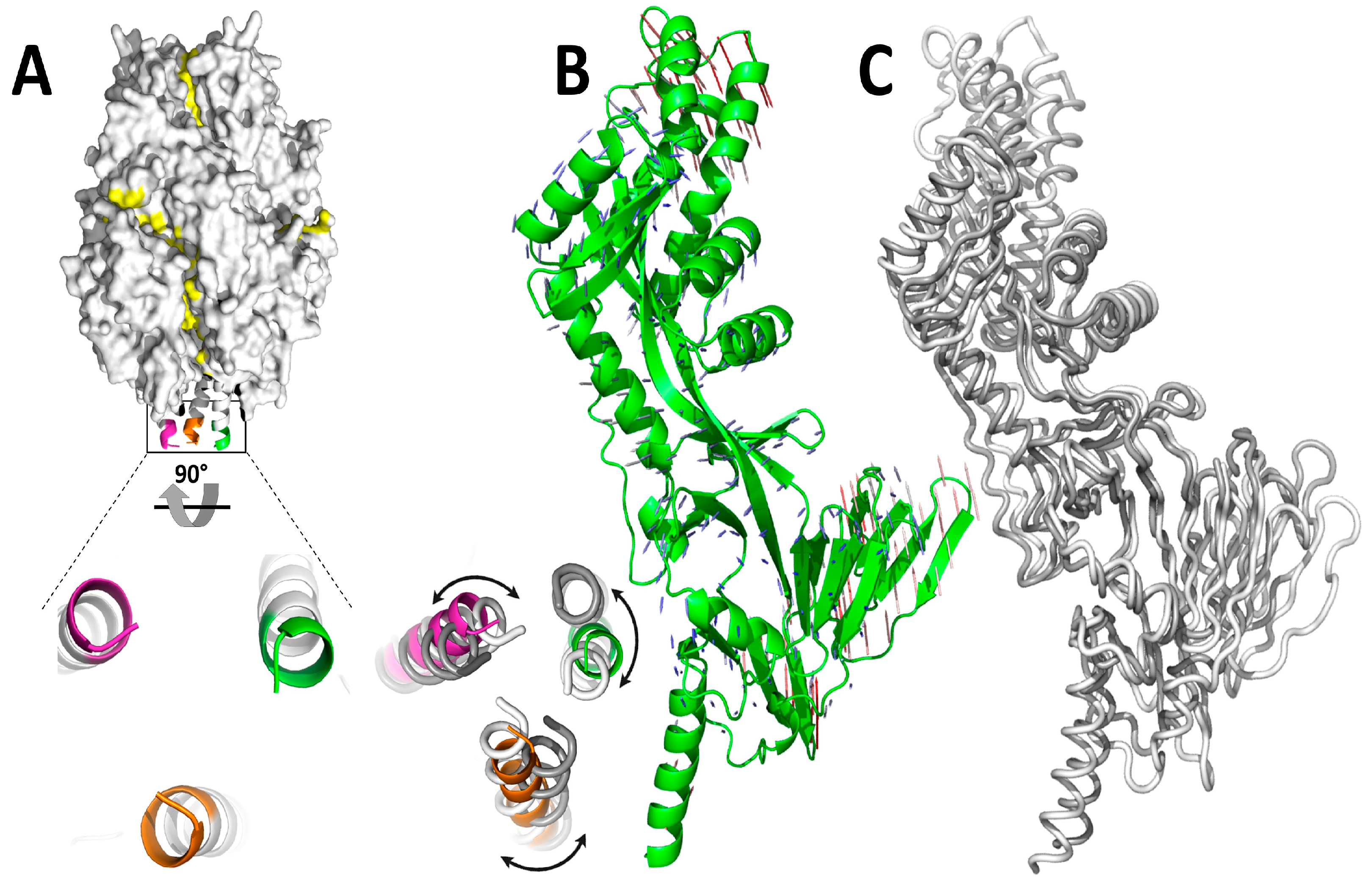
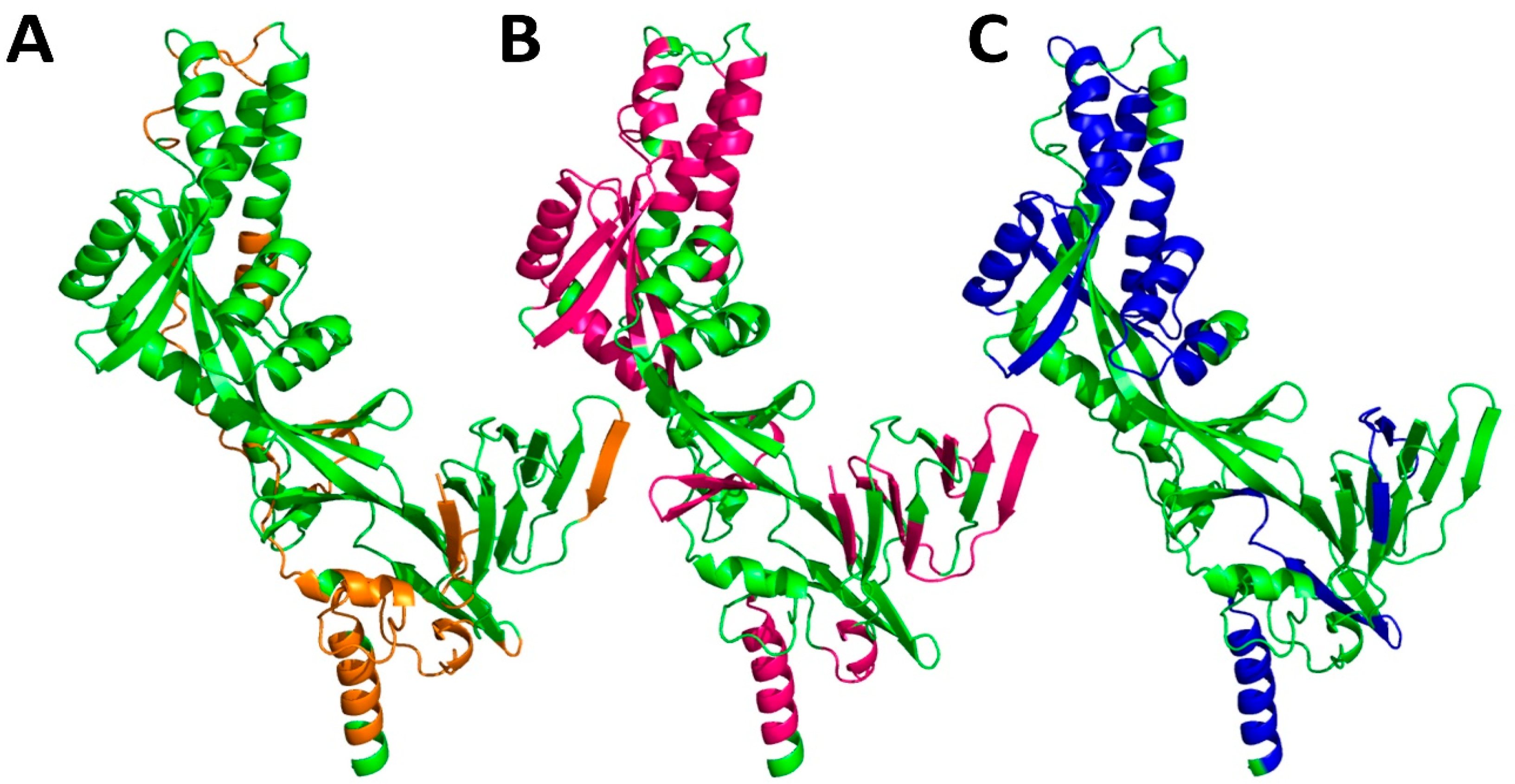
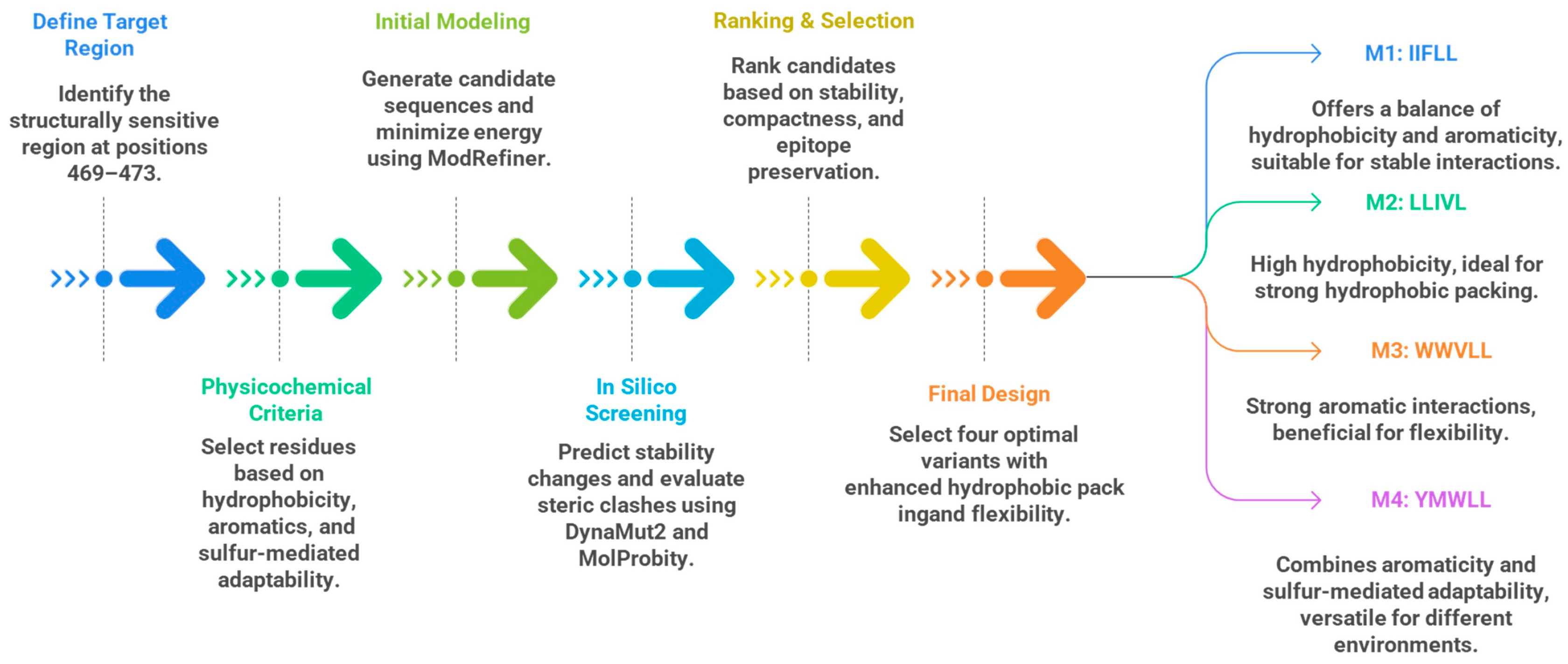

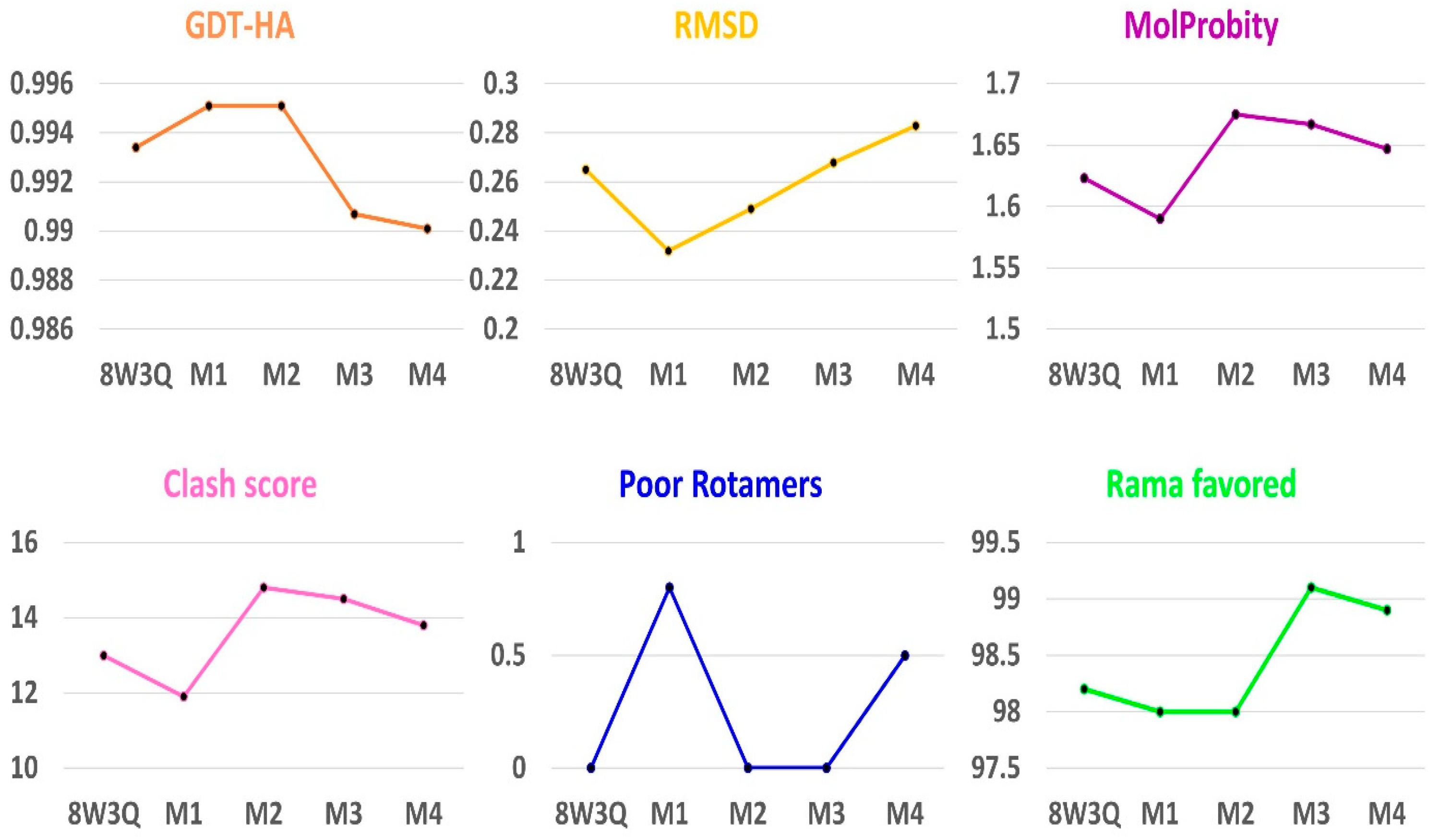


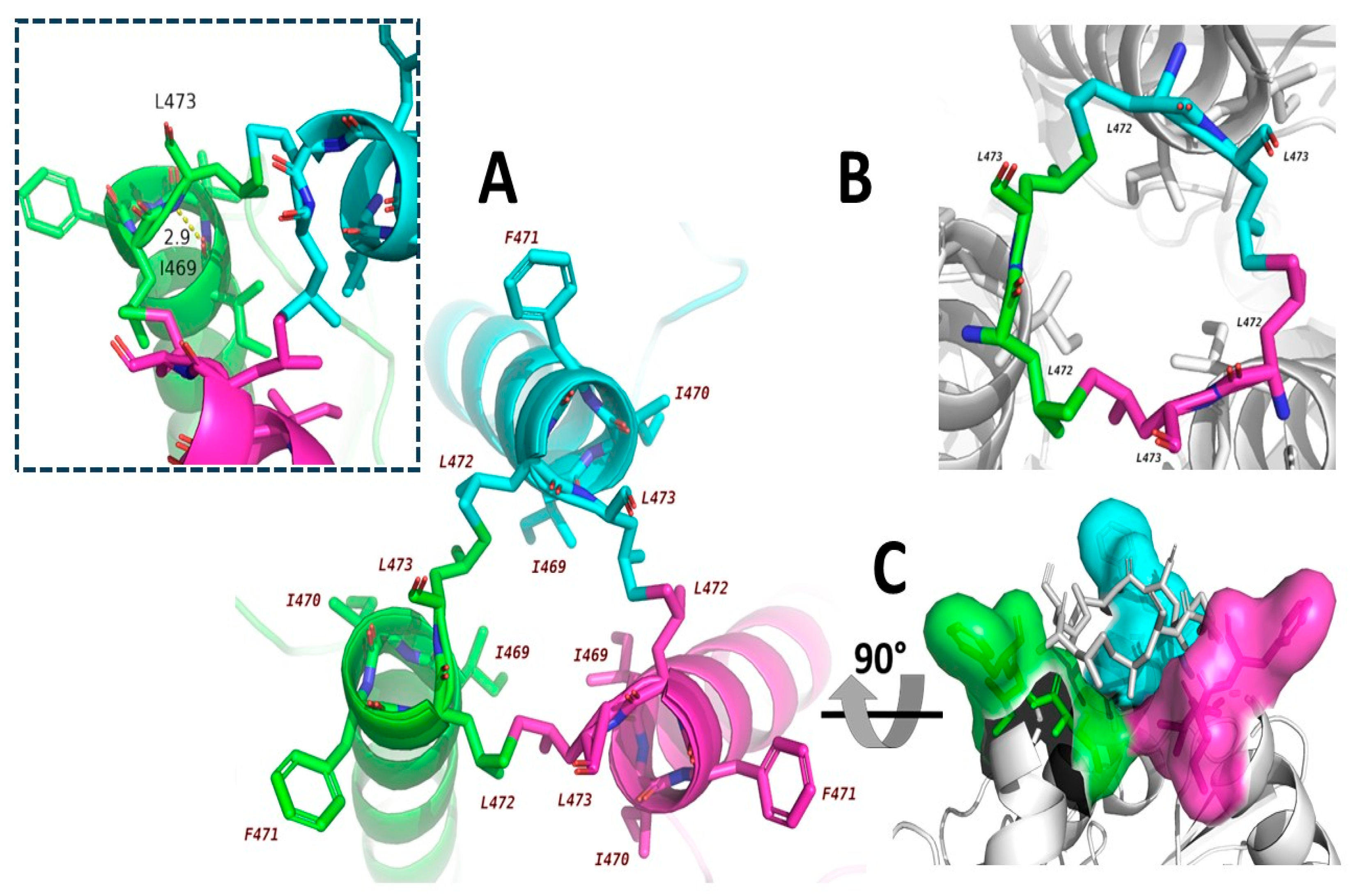
| Variant | GDT-HA | RMSD | MolProbity | Clash Score | Poor Rotamers | Rama Favoured |
|---|---|---|---|---|---|---|
| 8W3Q | 0.9934 | 0.265 | 1.623 | 13 | 0 | 98.2 |
| M1 | 0.9951 | 0.232 | 1.59 | 11.9 | 0.8 | 98 |
| M2 | 0.9951 | 0.249 | 1.675 | 14.8 | 0 | 98 |
| M3 | 0.9907 | 0.268 | 1.667 | 14.5 | 0 | 99.1 |
| M4 | 0.9901 | 0.283 | 1.647 | 13.8 | 0.5 | 98.9 |
| Variant | RMSD (nm) | Rg (nm) | RMSF (nm) | C-Term RMSF (nm) | α-Helix (%) | β-Sheet (%) |
|---|---|---|---|---|---|---|
| WT | 0.44 | 3.08 | 0.29 | 0.45 | 16.16 | 8.25 |
| M1 | 0.27 | 3.01 | 0.22 | 0.36 | 15.26 | 8.17 |
| M2 | 0.37 | 3.12 | 0.22 | 0.39 | 16.26 | 8.08 |
| M3 | 0.29 | 3.01 | 0.2 | 0.28 | 15.51 | 8.45 |
| M4 | 0.34 | 3.05 | 0.22 | 0.5 | 16.13 | 9.62 |
Disclaimer/Publisher’s Note: The statements, opinions and data contained in all publications are solely those of the individual author(s) and contributor(s) and not of MDPI and/or the editor(s). MDPI and/or the editor(s) disclaim responsibility for any injury to people or property resulting from any ideas, methods, instructions or products referred to in the content. |
© 2025 by the authors. Licensee MDPI, Basel, Switzerland. This article is an open access article distributed under the terms and conditions of the Creative Commons Attribution (CC BY) license (https://creativecommons.org/licenses/by/4.0/).
Share and Cite
Kumar, R.; Borkotoky, S.; Gupta, R.; Gupta, J.; Maji, S.; Tiwari, S.; Tyagi, R.K.; Oliva, B. Stabilizing the Shield: C-Terminal Tail Mutation of HMPV F Protein for Enhanced Vaccine Design. BioMedInformatics 2025, 5, 47. https://doi.org/10.3390/biomedinformatics5030047
Kumar R, Borkotoky S, Gupta R, Gupta J, Maji S, Tiwari S, Tyagi RK, Oliva B. Stabilizing the Shield: C-Terminal Tail Mutation of HMPV F Protein for Enhanced Vaccine Design. BioMedInformatics. 2025; 5(3):47. https://doi.org/10.3390/biomedinformatics5030047
Chicago/Turabian StyleKumar, Reetesh, Subhomoi Borkotoky, Rohan Gupta, Jyoti Gupta, Somnath Maji, Savitri Tiwari, Rajeev K. Tyagi, and Baldo Oliva. 2025. "Stabilizing the Shield: C-Terminal Tail Mutation of HMPV F Protein for Enhanced Vaccine Design" BioMedInformatics 5, no. 3: 47. https://doi.org/10.3390/biomedinformatics5030047
APA StyleKumar, R., Borkotoky, S., Gupta, R., Gupta, J., Maji, S., Tiwari, S., Tyagi, R. K., & Oliva, B. (2025). Stabilizing the Shield: C-Terminal Tail Mutation of HMPV F Protein for Enhanced Vaccine Design. BioMedInformatics, 5(3), 47. https://doi.org/10.3390/biomedinformatics5030047







